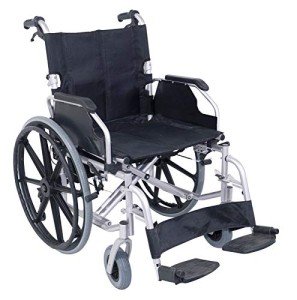Bariatric Wheelchair Seat Width
Seat Width
Having the proper seat width is necessary to wheelchair users who invest longer periods in their chairs. Too narrow a seat will cause pressure on the hips and thighs which could cause sores or pressure points. Having too broad a seat can likewise make it difficult for the user to reach the hand rims to propel themselves or maneuver in small areas.
To measure the appropriate seat width an individual would rest on a chair usually and have their measurement taken across their lap at the best point which is generally their hips. A wheelchair measuring tape can be utilized to measure this, but a backyard stick is preferred as it prevents people from covering the tape around their hips which would provide an unreliable outcome.
The standard wheelchair seat width is 16" (narrow grownup), 18" (standard adult), and 20" (wide adult). For bariatric patients, a 24" seat is offered. This durable additional large bariatric wheelchair from Medline features swing-away footrests, a carbon steel frame with rust- and chip-resistant chrome plating, and easy-to-clean vinyl upholstery. It has a weight capacity of 500 pounds.
Seat Depth
Traditionally, the seat depth of a bariatric wheelchair was added 2" to the measurement taken at the user's best point (generally their hips). This was indicated to accommodate additional layers of clothes that might be used during cold weather. However, this practice is ending up being less typical as wheelchair users have the ability to invest more time inside and are not wearing long coats. This makes the seat depth of a chair lesser when picking a bariatric wheelchair. Nevertheless, it is still essential to choose an option that provides adequate assistance for bigger users.
The Medline folding extra large bariatric manual wheelchair includes a comfy 24" seat width and a durable slide tube silver vein frame. It likewise has an adjustable axle and tool-free elevating legrests.
Seat Height
When it concerns figuring out the appropriate wheelchair seat width you ought to constantly determine from the user's widest point which is generally their hips. You will also need to consider whether the user is going to be using a winter season coat as this might include 2" to the width required.
When a wheelchair is in use it need to only be run on level surfaces with the wheel locks completely engaged. This is to avoid the chair from having the ability to move slopes that are 10 degrees or greater. It is likewise essential to bear in mind that any activity that might move the center of gravity in the chair should be finished with care. This consists of reaching for items that need the individual to lean out of their seat or trying to stand up from it.
Whenever you have the chair in use it is recommended that you regularly inspect it for damage and oil any locations that are considered required. For example, the casters need to be lubed by removing the caster fork and utilizing a multi-purpose grease to apply to the caster stem bearings. Similarly, the foot plates can be changed by loosening up the bolt and then moving them to the desired position. This permits the feet to sit conveniently on the footplate and prevents any pressure points from forming. This can be really uncomfortable for the user and if left ignored, can lead to pressure sores.
Weight Capacity

Bariatric wheelchairs are developed to support more weight than standard wheelchairs. This makes them tougher and much better geared up to manage falls. They are also generally larger and larger, making them less maneuverable in tight spaces than basic wheelchairs. They need automobiles with unique ramps and lifts to pack them, in addition to chauffeurs who understand how to best transport them from one location to the next.
When picking bariatric self propelled wheelchair , consider its weight capacity as it will be the primary determining aspect in whether it will accommodate your passenger's needs. The weight capacity of the chair is typically listed as a fixed load, meaning that it indicates the quantity of weight the chair can conveniently hold while standing still. However, some makers also note an active load that is based on a drop test and can replicate the result of somebody taking a seat in the chair. This might be a more reputable measurement of the weight limit, depending on your requirements.
If you prepare to carry out activities that shift your center of mass in the seat (such as grabbing things), make sure to have front casters pointed in a forward instructions and wheel locks engaged so the chair will not tip over. Also, check that casters are lubed routinely to avoid extreme wear and abrasions. The lubrication procedure involves eliminating the fork, separating the caster from the wheel, and greasing the caster stem bearings with premium multi-purpose grease.
